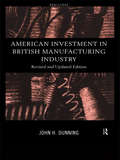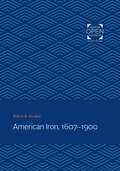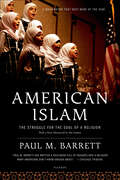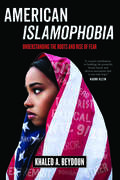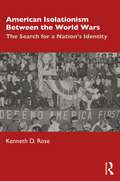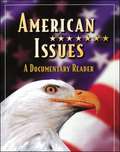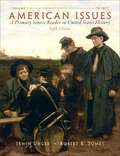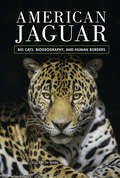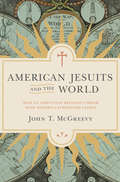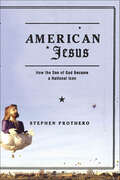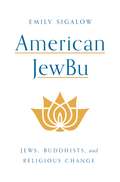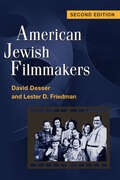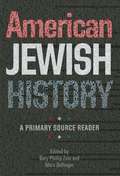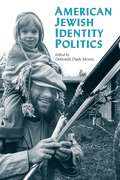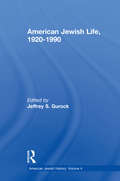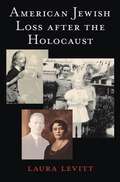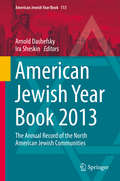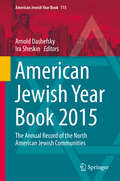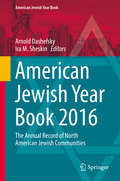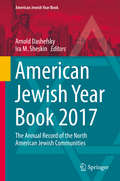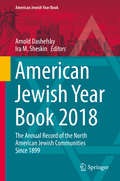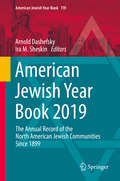- Table View
- List View
American Investment in British Manufacturing Industry
by John DunningThis classic work, first published in 1958, is a seminal text in international business history. This new, substantially updated and revised edition is being published on the fortieth anniversary of the first edition. Features of the revised edition include: * a new introduction * a new concluding chapter * amendments and additions to the original text * a new statistical appendix which examines the main features and significance of the US penetration of UK industry over the past four decades. Professor Dunning is one of the most internationally renowned and respected scholars in international business research. The updated version of this highly regarded book is a major contribution to studies in international business history.
American Iron, 1607-1900 (Johns Hopkins Studies in the History of Technology #19)
by Robert B. GordonWinner of the Professional and Scholarly Publishing Award for General Engineering from the Association of American PublishersOriginally published in 1996. By applying their abundant natural resources to ironmaking early in the eighteenth century, Americans soon made themselves felt in world markets. After the Revolution, ironmakers supplied the materials necessary to the building of American industry, pushing the fuel efficiency and productivity of their furnaces far ahead of their European rivals. In American Iron, 1607-1900, Robert B. Gordon draws on recent archaeological findings as well as archival research to present an ambitious, comprehensive survey of iron technology in America from the colonial period to the industry's demise at about the turn of the twentieth century. Closely examining the techniques—the "hows"—of ironmaking in its various forms, Gordon offers new interpretations of labor, innovation, and product quality in ironmaking, along with references to the industry's environmental consequences. He establishes the high level of skills required to ensure efficient and safe operation of furnaces and to improve the quality of iron product. By mastering founding, fining, puddling, or bloom smelting, ironworkers gained a degree of control over their lives not easily attained by others.
American Islam: The Struggle for the Soul of a Religion
by Paul M. BarrettVivid, dramatic portraits of Muslims in America in the years after 9/11, as they define themselves in a religious subculture torn between moderation and extremismThere are as many as six million Muslims in the United States today. Islam (together with Christianity and Judaism) is now an American faith, and the challenges Muslims face as they reconcile their intense and demanding faith with our chaotic and permissive society are recognizable to all of us.From West Virginia to northern Idaho, American Islam takes readers into Muslim homes, mosques, and private gatherings to introduce a population of striking variety. The central characters range from a charismatic black imam schooled in the militancy of the Nation of Islam to the daughter of an Indian immigrant family whose feminist views divided her father's mosque in West Virginia. Here are lives in conflict, reflecting in different ways the turmoil affecting the religion worldwide. An intricate mixture of ideologies and cultures, American Muslims include immigrants and native born, black and white converts, those who are well integrated into the larger society and those who are alienated and extreme in their political views. Even as many American Muslims succeed in material terms and enrich our society, Islam is enmeshed in controversy in the United States, as thousands of American Muslims have been investigated and interrogated in the wake of 9/11.American Islam is an intimate and vivid group portrait of American Muslims in a time of turmoil and promise.
American Islamophobia: Understanding The Roots And Rise Of Fear
by Khaled A. Beydoun“I remember the four words that repeatedly scrolled across my mind after the first plane crashed into the World Trade Center in New York City. ‘Please don’t be Muslims, please don’t be Muslims.’ The four words I whispered to myself on 9/11 reverberated through the mind of every Muslim American that day and every day after.… Our fear, and the collective breath or brace for the hateful backlash that ensued, symbolize the existential tightrope that defines Muslim American identity today.” The term “Islamophobia” may be fairly new, but irrational fear and hatred of Islam and Muslims is anything but. Though many speak of Islamophobia’s roots in racism, have we considered how anti-Muslim rhetoric is rooted in our legal system? Using his unique lens as a critical race theorist and law professor, Khaled A. Beydoun captures the many ways in which law, policy, and official state rhetoric have fueled the frightening resurgence of Islamophobia in the United States. Beydoun charts its long and terrible history, from the plight of enslaved African Muslims in the antebellum South and the laws prohibiting Muslim immigrants from becoming citizens to the ways the war on terror assigns blame for any terrorist act to Islam and the myriad trials Muslim Americans face in the Trump era. He passionately argues that by failing to frame Islamophobia as a system of bigotry endorsed and emboldened by law and carried out by government actors, U.S. society ignores the injury it inflicts on both Muslims and non-Muslims. Through the stories of Muslim Americans who have experienced Islamophobia across various racial, ethnic, and socioeconomic lines, Beydoun shares how U.S. laws shatter lives, whether directly or inadvertently. And with an eye toward benefiting society as a whole, he recommends ways for Muslim Americans and their allies to build coalitions with other groups. Like no book before it, American Islamophobia offers a robust and genuine portrait of Muslim America then and now.
American Isolationism Between the World Wars: The Search for a Nation's Identity
by Kenneth D. RoseAmerican Isolationism Between the World Wars: The Search for a Nation's Identity examines the theory of isolationism in America between the world wars, arguing that it is an ideal that has dominated the Republic since its founding. During the interwar period, isolationists could be found among Republicans and Democrats, Catholics and Protestants, pacifists and militarists, rich and poor. While the dominant historical assessment of isolationism — that it was "provincial" and "short-sighted" — will be examined, this book argues that American isolationism between 1919 and the mid-1930s was a rational foreign policy simply because the European reversion back to politics as usual insured that the continent would remain unstable. Drawing on a wide range of newspaper and journal articles, biographies, congressional hearings, personal papers, and numerous secondary sources, Kenneth D. Rose suggests the time has come for a paradigm shift in how American isolationism is viewed. The text also offers a reflection on isolationism since the end of World War II, particularly the nature of isolationism during the Trump era. This book will be of interest to students and scholars of U.S. Foreign Relations and twentieth-century American history.
American Issues: A Documentary Reader
by Charles M. Dollar Gary W. ReichardA collection of primary, secondary, and visual source documents on American history, covering the period from early exploration of the New World to present times.
American Issues: to 1877, 5th Edition
by Irwin Unger Robert R. TomesThe first of a two-volume anthology of primary documents, letters, and articles through which participants and contemporary observers express their opinions, make observations, and reach conclusions about events and issues that affected the nation and American society.
American Jaguar: Big Cats, Biogeography, and Human Borders
by Elizabeth WebbIn the borderlands between the United States and Mexico, America's largest cat—the jaguar—is fighting to regain its kingdom. Added to the endangered species list in 1997, the jaguar has declined in population mainly due to habitat fragmentation created by roads, farms, mines, and most controversially, the border wall. Such human-made barriers prevent free movement of many wild animals for predation and mating, thereby threatening their reproduction, DNA transfer, and overall survival. Author and wildlife biologist Elizabeth Webb examines the jaguar's predicament and highlights the work of field scientists who are searching for solutions. "Conservation Connection" features throughout the book underscore the importance of protecting this keystone species of the Americas.
American Jennie: The Remarkable Life of Lady Randolph Churchill
by Anne SebbaA frank account of the tempestuous life of the American mother of Britain's most important twentieth-century politician. Brooklyn-born Jennie Jerome married into the British aristocracy in 1874, after a three-day romance. She became Lady Randolph Churchill, wife of a maverick politician and mother of the most famous British statesman of the century. Jennie Churchill was not merely the most talked about and controversial American woman in London society, she was a dynamic behind-the-scenes political force and a woman of sexual fearlessness at a time when women were not supposed to be sexually liberated. A concert pianist, magazine founder and editor, and playwright, she was also, above all, a devoted mother to Winston. In American Jennie, Anne Sebba draws on newly discovered personal correspondences and archives to examine the unusually powerful mutual infatuation between Jennie and her son and to relate the passionate and ultimately tragic career of the woman whom Winston described as having "the wine of life in her veins."
American Jesuits and the World: How an Embattled Religious Order Made Modern Catholicism Global
by John T. McgreevyAt the start of the nineteenth century, the Jesuits seemed fated for oblivion. Dissolved as a religious order in 1773 by one pope, they were restored in 1814 by another, but with only six hundred aged members. Yet a century later, the Jesuits numbered seventeen thousand men and were at the vanguard of the Catholic Church's expansion around the world. In the United States especially, foreign-born Jesuits built universities and schools, aided Catholic immigrants, and served as missionaries. This book traces this nineteenth-century resurgence, showing how Jesuits nurtured a Catholic modernity through a disciplined counterculture of parishes, schools, and associations.Drawing on archival materials from three continents, American Jesuits and the World tracks Jesuits who left Europe for America and Jesuits who left the United States for missionary ventures across the Pacific. Each chapter tells the story of a revealing or controversial event, including the tarring and feathering of an exiled Swiss Jesuit in Maine, the efforts of French Jesuits in Louisiana to obtain Vatican approval of a miraculous healing, and the educational efforts of American Jesuits in Manila. These stories place the Jesuits at the center of the worldwide clash between Catholics and liberal nationalists, and reveal how the Jesuits not only revived their own order but made modern Catholicism more global.The result is a major contribution to modern global history and an invaluable examination of the meaning of religious liberty in a pluralistic age.
American Jesus: How the Son of God Became a National Icon
by Stephen ProtheroThe many guises in which Jesus has been represented.
American Jesus: How the Son of God Became a National Icon
by Stephen ProtheroA Deep Dive into America's Complex Relationship with JesusThere's no denying America's rich religious background–belief is woven into daily life. But as Stephen Prothero argues in American Jesus, many of the most interesting appraisals of Jesus have emerged outside the churches: in music, film, and popular culture; and among Jews, Muslims, Buddhists, and people of no religion at all.Delve into this compelling chronicle as it explores how Jesus, the carpenter from Nazareth, has been refashioned into distinctly American identities over the centuries. From his enlistment as a beacon of hope for abolitionists to his appropriation as a figurehead for Klansmen, the image of Jesus has been as mercurial as it is influential. In this diverse and conflicted scene, American Jesus stands as a testament to the peculiar fusion of the temporal and divine in contemporary America.Equal parts enlightening and entertaining, American Jesus goes beyond being simply a work of history. It’s an intricate mirror, reflecting the American spirit while questioning the nation's socio-cultural fabric.
American JewBu: Jews, Buddhists, and Religious Change
by Emily SigalowA revealing look at the Jewish American encounter with BuddhismToday, many Jewish Americans are embracing a dual religious identity, practicing Buddhism while also staying connected to their Jewish roots. This book tells the story of Judaism's encounter with Buddhism in the United States, showing how it has given rise to new contemplative forms within American Judaism—and shaped the way Americans understand and practice Buddhism.Taking readers from the nineteenth century to today, Emily Sigalow traces the history of these two traditions in America and explains how they came together. She argues that the distinctive social position of American Jews led them to their unique engagement with Buddhism, and describes how people incorporate aspects of both into their everyday lives. Drawing on a wealth of original in-depth interviews conducted across the nation, Sigalow explores how Jewish American Buddhists experience their dual religious identities. She reveals how Jewish Buddhists confound prevailing expectations of minority religions in America. Rather than simply adapting to the majority religion, Jews and Buddhists have borrowed and integrated elements from each other, and in doing so they have left an enduring mark on the American consciousness.American JewBu highlights the leading role that American Jews have played in the popularization of meditation and mindfulness in the United States, and the profound impact that these two venerable traditions have had on one another.
American Jewish Filmmakers
by Lester D. Friedman David DesserWoody Allen, Mel Brooks, Sidney Lumet, and Paul Mazursky, all sons of East European Jews, remain among the most prominent contemporary American film directors. In this revised, updated second edition of American Jewish Filmmakers, David Desser and Lester D. Friedman demonstrate how the Jewish experience gives rise to an intimately linked series of issues in the films of these and other significant Jewish directors. The effects of the Holocaust linger, both in gripping dramatic form (Mazursky's Enemies, a Love Story) and in black comedy (Brooks's The Producers). In his trilogy consisting of Serpico, Prince of the City, and Q&A, Lumet focuses on the failure of society's institutions to deliver social justice. Woody Allen portrays urban life and family relationships (Manhattan and Hannah and Her Sisters), sometimes with a nostalgic twist (Radio Days). This edition concludes with a newly written discussion of the careers of other prominent Jewish filmmakers such as Steven Spielberg, Barry Levinson, Brian Singer, and Darren Aronofsky.
American Jewish History: A Primary Source Reader
by Marc Dollinger Gary ZolaPresenting the American Jewish historical experience from its communal beginnings to the present through documents, photographs, and other illustrations, many of which have never before been published, this entirely new collection of source materials complements existing textbooks on American Jewish history with an organization and pedagogy that reflect the latest historiographical trends and the most creative teaching approaches. Ten chapters, organized chronologically, include source materials that highlight the major thematic questions of each era and tell many stories about what it was like to immigrate and acculturate to American life, practice different forms of Judaism, engage with the larger political, economic, and social cultures that surrounded American Jews, and offer assistance to Jews in need around the world. At the beginning of each chapter, the editors provide a brief historical overview highlighting some of the most important developments in both American and American Jewish history during that particular era. Source materials in the collection are preceded by short headnotes that orient readers to the documentsÕ historical context and significance.
American Jewish Identity Politics
by Deborah Dash MooreWritten by scholars who grew up after World War II and the Holocaust who participated in political struggles in the 1960s and 1970s and who articulated many of the formative concepts of modern Jewish studies, this anthology provides a window into an era of social change. These men and women are among the leading scholars of Jewish history, society and culture. The volume is organized around contested themes in American Jewish life: the Holocaust and World War II, religious pluralism and authenticity, intermarriage and Jewish continuity. Thus, it offers one of the few opportunities for students to learn about these debates from participant scholars.
American Jewish Landmarks: A Travel Guide and History, Volume I
by Bernard Postal Lionel Koppman"American Jewish Landmarks" contains valuable historical data on all 50 states, Washington, D.C., Puerto Rico, and the Virgin Islands; and is required reading for people interested in the Jewish landmarks of the United States and her territorial possessions. It is also worth bearing in mind that this book is more than a manual for the tourist, it is an important book for students of American Jewish history.
American Jewish Life, 1920-1990: American Jewish History (American Jewish History #4)
by Jeffrey S. GurockThis volume contains articles on Jewish life from 1920 to the present. Its entries include studies of the economy and migration in postwar America, the impact of Holocaust survivors on American Society and the reaction to gender stereotypes within American Culture.
American Jewish Loss after the Holocaust
by Laura LevittMany of us belong to communities that have been scarred by terrible calamities. And many of us come from families that have suffered grievous losses. How we reflect on these legacies of loss and the ways they inform each other are the questions Laura Levitt takes up in this provocative and passionate book.An American Jew whose family was not directly affected by the Holocaust, Levitt grapples with the challenges of contending with ordinary Jewish loss. She suggests that although the memory of the Holocaust may seem to overshadow all other kinds of loss for American Jews, it can also open up possibilities for engaging these more personal and everyday legacies.Weaving in discussions of her own family stories and writing in a manner that is both deeply personal and erudite, Levitt shows what happens when public and private losses are seen next to each other, and what happens when difficult works of art or commemoration, such as museum exhibits or films, are seen alongside ordinary family stories about more intimate losses. In so doing she illuminates how through these “ordinary stories” we may create an alternative model for confronting Holocaust memory in Jewish culture.
American Jewish Year Book 2012: The Annual Record of the North American Jewish Communities (American Jewish Year Book #113)
by Ira Sheskin Arnold DashefskyThe 2012 American Jewish Year Book, "The Annual Record of American Jewish Civilization," contains major chapters on Jewish secularism (Barry Kosmin and Ariela Keysar), Canadian Jewry (Morton Weinfeld, David Koffman, and Randal Schnoor), national affairs (Ethan Felson), Jewish communal affairs (Lawrence Grossman), Jewish population in the United States (Ira Sheskin and Arnold Dashefsky), and World Jewish population (Sergio DellaPergola). These chapters provide insight into major trends in the North American and world Jewish community. The volume also acts as a resource for the American Jewish community and for academics studying that community by supplying obituaries and lists of Jewish Federations, Jewish Community Centers, national Jewish organizations, Jewish overnight camps, Jewish museums, Holocaust museums, local and national Jewish periodicals, Jewish honorees, major recent events in the American Jewish community, and academic journals, articles, websites, and books. The volume should prove useful to social scientists and historians of the American Jewish community, Jewish communal workers, the press, and others interested in American and Canadian Jews.
American Jewish Year Book 2015: The Annual Record of the North American Jewish Communities (American Jewish Year Book #115)
by Arnold Dashefsky Ira M. SheskinThis Year Book, now in its 115th year, provides insight into major trends in the North American Jewish communities and is the Annual Record of the North American Jewish Communities. The first two chapters of Part I examine Jewish immigrant groups to the US and Jewish life on campus. Chapters on "National Affairs" and "Jewish Communal Affairs" analyze the year's events. Three chapters analyze the demography and geography of the US, Canada, and world Jewish populations. Part II provides Jewish Federations, Jewish Community Centers, social service agencies, national organizations, overnight camps, museums, and Israeli consulates. The final chapters present national and local Jewish periodicals and broadcast media; academic resources, including Jewish Studies Programs, books, articles websites, and research libraries; and lists of major events in the past year, Jewish honorees, and obituaries. For those interested in the North American Jewish community--scholars, service providers, volunteers--this volume undoubtedly provides the single best source of information on the structure, dynamics, and ongoing religious, political, and social challenges confronting the community. It should be on the bookshelf of everyone interested in monitoring the dynamics of change in the Jewish communities of North America. Sidney Goldstein, Founder and Director, Population Studies and Training Center, Brown University, and Alice Goldstein, Population Studies and Traini ng Center, Brown University The American Jewish Year Book is a unique and valuable resource for Jewish community professionals. It is part almanac, directory, encyclopedia and all together a volume to have within easy reach. It is the best, concise diary of trends, events, and personalities of interest for the past year. We should all welcome the Year Book's publication as a sign of vitality for the Jewish community. Brenda Gevertz, Executive Director, JPRO Network, the Jewish Professional Resource Organization
American Jewish Year Book 2016: The Annual Record of North American Jewish Communities (American Jewish Year Book #116)
by Arnold Dashefsky Ira M. SheskinThe American Jewish Year Book, now in its 116th year, is the annual record of the North American Jewish communities and provides insight into their major trends. Part I presents a forum on the Pew Survey, "A Portrait of American Orthodox Jews. " Part II begins with Chapter 13, "The Jewish Family. " Chapter 14 examines "American Jews and the International Arena (April 1, 2015 - April 15, 2016), which focuses on US-Israel Relations. Chapters 15-17 analyze the demography and geography of the US, Canadian, and world Jewish populations. In Part III, Chapter 18 provides lists of Jewish institutions, including federations, community centers, social service agencies, national organizations, synagogues, Hillels, day schools, camps, museums, and Israeli consulates. In the final chapters, Chapter 19 presents national and local Jewish periodicals and broadcast media; Chapter 20 provides academic resources, including Jewish Studies programs, books, articles, websites, and research libraries; and Chapter 21 presents lists of major events in the past year, Jewish honorees, and obituaries. An invaluable record of Jewish life, the American Jewish Year Book illuminates contemporary issues with insight and breadth. It is a window into a complex and ever-changing world. Deborah Dash Moore, Frederick G. L. Huetwell Professor of History and Judaic Studies, and Director Emerita of the Frankel Center for Judaic Studies, University of Michigan A century from now and more, the stately volumes of the American Jewish Year Book will stand as the authoritative record of Jewish life since 1900. For anyone interested in tracing the long-term evolution of Jewish social, political, religious, and cultural trends from an objective yet passionately Jewish perspective, there simply is no substitute. Lawrence Grossman, American Jewish Year Book Editor (1999-2008) and Contributor (1988-2015)
American Jewish Year Book 2017: The Annual Record of the North American Jewish Communities (American Jewish Year Book #117)
by Arnold Dashefsky Ira M. SheskinThe American Jewish Year Book, now in its 117th year, is the annual record of the North American Jewish communities and provides insight into their major trends. The first chapter of Part I is an examination of how American Jews fit into the US religious landscape, based on Pew Research Center studies. The second chapter examines intermarriage. Chapters on "The Domestic Arena" and "The International Arena" analyze the year's events as they affect American Jewish communal and political affairs. Three chapters analyze the demography and geography of the US, Canada, and world Jewish populations. Part II provides lists of Jewish institutions, including federations, community centers, social service agencies, national organizations, synagogues, Hillels, day schools, camps, museums, and Israeli consulates. The final chapters present national and local Jewish periodicals and broadcast media; academic resources, including Jewish Studies programs, books, journals, articles, websites, and research libraries; and lists of major events in the past year, Jewish honorees, and obituaries.
American Jewish Year Book 2018: The Annual Record Of The North American Jewish Communities Since 1899 (American Jewish Year Book #118)
by Arnold Dashefsky Ira M. SheskinThe American Jewish Year Book, now in its 118th year, is the annual record of the North American Jewish communities and provides insight into their major trends. The first two chapters of Part I include a special forum on "Contemporary American Jewry: Grounds for Optimism or Pessimism?" with assessments from more than 20 experts in the field. The third chapter examines antisemitism in Contemporary America. Chapters on “The Domestic Arena” and “The International Arena” analyze the year’s events as they affect American Jewish communal and political affairs. Three chapters analyze the demography and geography of the US, Canada, and world Jewish populations. Part II provides lists of Jewish institutions, including federations, community centers, social service agencies, national organizations, synagogues, Hillels, day schools, camps, museums, and Israeli consulates. The final chapters present national and local Jewish periodicals and broadcast media; academic resources, including Jewish Studies programs, books, journals, articles, websites, and research libraries; and lists of major events in the past year, Jewish honorees, and obituaries.
American Jewish Year Book 2019: The Annual Record of the North American Jewish Communities Since 1899 (American Jewish Year Book #119)
by Arnold Dashefsky Ira M. SheskinPart I of each volume will feature 5-7 major review chapters, including 2-3 long chapters reviewing topics of major concern to the American Jewish community written by top experts on each topic, review chapters on "National Affairs" and "Jewish Communal Affairs" and articles on the Jewish population of the United States and the World Jewish Population. Future major review chapters will include such topics as Jewish Education in America, American Jewish Philanthropy, Israel/Diaspora Relations, American Jewish Demography, American Jewish History, LGBT Issues in American Jewry, American Jews and National Elections, Orthodox Judaism in the US, Conservative Judaism in the US, Reform Judaism in the US, Jewish Involvement in the Labor Movement, Perspectives in American Jewish Sociology, Recent Trends in American Judaism, Impact of Feminism on American Jewish Life, American Jewish Museums, Anti-Semitism in America, and Inter-Religious Dialogue in America. Part II-V of each volume will continue the tradition of listing Jewish Federations, national Jewish organizations, Jewish periodicals, and obituaries. But to this list are added lists of Jewish Community Centers, Jewish Camps, Jewish Museums, Holocaust Museums, and Jewish honorees (both those honored through awards by Jewish organizations and by receiving honors, such as Presidential Medals of Freedom and Academy Awards, from the secular world). We expand the Year Book tradition of bringing academic research to the Jewish communal world by adding lists of academic journals, articles in academic journals on Jewish topics, Jewish websites, and books on American and Canadian Jews. Finally, we add a list of major events in the North American Jewish Community.
